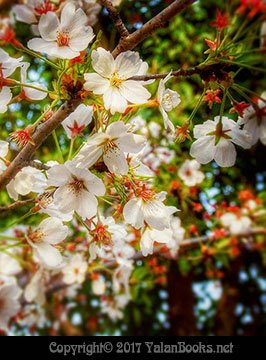
Chunfen,is the 4th solar terms in traditional East Asian calendars.
It begins when the sun reaches the celestial longitude of 0° and ends when it reaches the longitude of 15°, which usually falls from March 20 to April 4 in the Gregorian calendar. According to Chinese calendar, Chunfen has 3 pentads:
the 1st pentad – the dark birds arrive (the swallows return)
the 2nd pentad – thunder makes sounds (spring thunderstorm is coming)
the 3rd pendad – lightning begins (thunderstorms start,daytime is longer)
However, Chunfen often refers to its start day, March 20 or 21, when the sun is exactly at the equator, equalizing the day and the night. It used to being celebrated as a holiday in ancient China, followed with the imperial ceremony to worship the sun. Chinese folks considered it the real beginning of spring walk to the beautiful nature, holding activities like kite-flying for women and children, wearing flowers in the hair for some drinking party, going to countryside to pick the wild herbs with family or friends then cooking those veggies at home to share the fresh taste of spring . What a charming time! So many poets got inspired by the beauty of spring and wrote down numerous great poems, which no doubt created a fortune in Chinese literature.
. What a charming time! So many poets got inspired by the beauty of spring and wrote down numerous great poems, which no doubt created a fortune in Chinese literature.
It’s kind of pity that now only 2 solar terms (Qingming, Duanwu)remain Chinese holidays among 24 terms, while Chunfen and Qiufen are still national holidays in Japan.Imagine how terrific it would be to take a spring walk in the beautiful sakura woods during the day of Chunfen! Lighted up at night, the white, pink blossoms become as surreal as a fantastic dream. Further more, in Iranian calendar, the same day turns to be Nowruz (known as the Iranian New Year or the Persian New Year), celebrated in Iran and other 15 countries of Western Asia & Central Asia which have been influenced by ancient Persian culture,such as Turkey, Afghanistan, Irag, including some ethic groups of India and Chinese Xinjiang Area. What impress me are some decorative tables,basically requiring 7 items starting with the letter S or seen in the Perso-Arabic alphabet, which mostly contains greenery, apple, sweets, dried fruit, berries, garlic and vinegar. Along with the candles, fine mirror, decorating coins & eggs, the elegant table cloth and Persian carpet, hooray, the whole table setting just looks like an amazing oil painting of still life…
001
002 The lupine flowers
003 Chinese hydrnagea
004
Interested in Japan’s sakura? Check this amazing blog post: Atop Mt. Matsuda
145 Readers like the post(此文不错,朕喜欢)
the Next:Early April, a Charming Flower Season (Drawings)
the Previous:KeeLung Coast (II) – the Historic Fortress of Baimiweng(Photos)

引经据典,信手拈来,才女啊!
不要夸奖我,我会很骄傲的。。 😉 =))
岚姐博古通今,学贯中西,实乃旷世奇才啊 :)) :)) :))
O:-) 承让承让。。彼此彼此。。 =))
记得以前小时候,我们应该也是这个时候到农田去挖野菜,那时候的野菜还是很多很好吃的,现在的农田已经没有野菜了。
是啊 ;;) 绿色无污染的野菜几乎绝迹了,大概人迹罕至的高山上才有。。
博主的言辞,让我想到古色古香的绝世佳人!
多谢你美言… O:-) :))
总算更新了,等了好久
试试写个十年的Blog,你就会发觉更新是一件非常痛苦的事情 😉 :))
这么多年,你的博客一直都在坚持,厉害。
也没什么 ;;) 想写就写,不想写就不写咯
春暖花开,引得燕来!
燕子飞时,绿水人家绕。枝上柳绵吹又少,天涯何处无芳草 ;;)
鲁冰花好像迎春花吗?
终于春天要来了,前一阵子太冷了。
TW茶园附近常见的植物,充作绿肥 ;;)
《鲁冰花》是有关客家人的影视作品,同名歌曲赞扬母爱,颇受欢迎 🙂 以前在学校里一直听到这首歌,终于看到这花长什么样了 :))
好有文采,作家来的?
3 Q O:-) 随便写写
生活费没攒够,今天不能回家养花花草草了;我又 :(( 失去了第一猛将的身份。
相差不多啦,不用桑心 … O:-)
:)) 烟花三月下扬州,走起 =))
春风得意马蹄疾,一日看尽长安花。。 :evil 。 :))
春天来了,夏天还会远吗?
然。。 秋冬也不远了。。 😉
:)) :)) 主要是我最喜欢的是夏天。
我倒是比较喜欢5月10月,夏天太热了 L-)
原来鲁冰花是这样的啊。。。有点像油菜花 B-)
豆科植物嘛 😀 花色有红粉蓝白黄,TW茶农以其为绿肥,种植黄色居多
真渊博……看的一愣一愣的。
查一查资料也就知道了嘛。。 :))
色调的很好哎